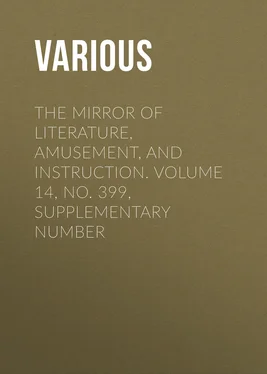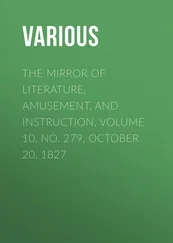Various - The Mirror of Literature, Amusement, and Instruction. Volume 14, No. 399, Supplementary Number
Здесь есть возможность читать онлайн «Various - The Mirror of Literature, Amusement, and Instruction. Volume 14, No. 399, Supplementary Number» — ознакомительный отрывок электронной книги совершенно бесплатно, а после прочтения отрывка купить полную версию. В некоторых случаях можно слушать аудио, скачать через торрент в формате fb2 и присутствует краткое содержание. Жанр: foreign_antique, periodic, Развлечения, foreign_edu, на английском языке. Описание произведения, (предисловие) а так же отзывы посетителей доступны на портале библиотеки ЛибКат.
- Название:The Mirror of Literature, Amusement, and Instruction. Volume 14, No. 399, Supplementary Number
- Автор:
- Жанр:
- Год:неизвестен
- ISBN:нет данных
- Рейтинг книги:3 / 5. Голосов: 1
-
Избранное:Добавить в избранное
- Отзывы:
-
Ваша оценка:
- 60
- 1
- 2
- 3
- 4
- 5
The Mirror of Literature, Amusement, and Instruction. Volume 14, No. 399, Supplementary Number: краткое содержание, описание и аннотация
Предлагаем к чтению аннотацию, описание, краткое содержание или предисловие (зависит от того, что написал сам автор книги «The Mirror of Literature, Amusement, and Instruction. Volume 14, No. 399, Supplementary Number»). Если вы не нашли необходимую информацию о книге — напишите в комментариях, мы постараемся отыскать её.
The Mirror of Literature, Amusement, and Instruction. Volume 14, No. 399, Supplementary Number — читать онлайн ознакомительный отрывок
Ниже представлен текст книги, разбитый по страницам. Система сохранения места последней прочитанной страницы, позволяет с удобством читать онлайн бесплатно книгу «The Mirror of Literature, Amusement, and Instruction. Volume 14, No. 399, Supplementary Number», без необходимости каждый раз заново искать на чём Вы остановились. Поставьте закладку, и сможете в любой момент перейти на страницу, на которой закончили чтение.
Интервал:
Закладка:
Various
The Mirror of Literature, Amusement, and Instruction / Volume 14, No. 399, Supplementary Number
Verona
SPIRIT OF THE ANNUALS FOR 1830
Fair and gentle readers, we present you with a kaleidoscopic view of some of these elegant trifles—the very bijouterie of art and literature—in picture outmastering each other in gems of ingenuity, and in print, exalting a thousand beautiful fancies into a halo of harmony and happiness for the coming year. We call these "trifles," but in the best sense of the term—ay, the air-plants of literature, whose light flowers and fancies shoot up and entwine with our best affections, and even lend a charm to the loveliest of their objects.
We commence with
almost the "youngling of the flock," which contains the original of the annexed Engraving, by W.J. Cooke, appended to which is the following illustrative sketch:—
VERONA
The drawing from which our engraving is made, is one of the relics of the late Mr. Bonington, whose early death has caused such great and just regret to the lovers of painting. It represents one of those ancient towers, and one of those magnificent palaces, (the Maffei Palace), which distinguish the city of Verona, and, by their peculiar character mark it both as the ancient Gothic capital of northern Italy, and as one of the great principalities of the middle ages.
Verona is indebted to nature for part of the charms it possesses for a traveller. It is nearly surrounded by the broad and rapid Adige: the hills towards the Tyrol have a majestic character, which, as they approach the city, is softened by vineyards, and fields, and gardens, between agreeable villas or groves of cypress. The dress of the people is picturesque; their habits are cheerful, and their manners kindly.
Besides all this, there is scarcely a city, even in Italy, to which we attach a more romantic interest than to Verona. Under its ancient Gothic name of Bern, it is the scene of many of the Teutonic tales which are woven into the Book of Heroes, and the song of the Nibelung. The poets and novelists of the middle ages have also laid the scenes of many of their enchanting tales in this beautiful city; and our own Shakspeare has brought Verona so home to every English reader, that we feel almost to have a right of possession in the place.
Originally a city of the Rhetians, Verona became a Roman colony about the time of Julius Caeser, who caused its inhabitants to be enrolled among the number of Roman citizens. Its most flourishing periods under the empire were the reigns of Vaspasian and of Hadrian, when various temples, and other public buildings, of which some fragments still remain, were erected, and the magnificent ampitheatre, which is still used for scenic representations, was built. It was under the reign of Trajan, that Verona received its first Christian Bishop, Euprepius; and in that of Dioclesian, that its martyrs, Fermus and Rusticus, suffered. The conquest of the city by Constantine, and the fearful battle fought in its immediate neighbourhood between Stilicho and Attila, produced little change in the condition of Verona, which continued to partake of the general fortunes of the empire, until the reign of Theodoric the Great.
After the invasion of Italy by the Ostrogoths, under Theodoric, and his victory over Odoacer, which ensured him the sovereignty of the country, from the Alps to Calabria, about the year 493, he fixed his capital at Verona, or, as it was called by the Goths, Bern: 1 1 See Gibbon's "Decline and Fall," chap. 39, for the general conduct of Theodoric in Italy.
there he built a magnificent palace, which communicated, by a continued portico, with principal gate of the city. He renewed the Roman walls and fortifications, repaired the aqueducts, and constructed commodious baths and other public buildings. 2 2 Tiraboschi, book i.
After the death of Theodoric, A.D. 526, in the 37th year of his reign, the disturbed reigns of his daughter Amalasontha and her son Athalaric were an earnest of the distractions that Verona suffered, in common with the rest of Italy, till the taking of the city by Charlemagne, when a short period of tranquillity was enjoyed. Yet there a part of the great family tragedy, which secured his possession of the empire, was acted. He found in the town the widow and children of his brother Carloman, and they were sacrificed to his security. His eldest son, Pepin Hunchback, died at Verona, and was buried in St. Zeno's church, which he had founded. The present magnificent temple stands nearly on the site of Pepin's humbler foundation; and the great stone, now shown in the court, called the tomb of King Pepin, is very possibly that of Charlemagne's son.
During the disastrous period that followed, Verona underwent all the evils that its situation (at the very entrance to Italy from Germany) was so peculiarly calculated to draw upon it. The invasions of the Othos, the wars of the Guelfs and Ghibelines, the struggles of the people against oppression, and between the oppressors for power, from time to time distressed the city and robbed the citizens. Yet the very struggle for freedom and power ensured a portion of the former to the people, who were courted by all parties; and Verona became rich by the visits of her masters, and of such as courted her assistance. But it was in the thirteenth century that she became the queen of northern Italy, under the reign of the Scaligers, or della Scalas, who, from simple citizens, were raised, by their valour, their humanity, and the free choice of the people, to the sovereignty of the state.
During one hundred and twenty-seven years, ten princes of that illustrious house reigned in Verona. The first six were men of extraordinary talent, and, for the time in which they lived, of extraordinary virtue. They not only enlarged the boundaries of the Veronese, but subjected several distant cities. Albert della Scala added Trent and Riva, Parma and Reggio, Belluno and Vicenza, to his dominions; and Can Grande conquered Padua, Trevigi, Mantua, and Feltre. It is his body that is laid in the plain sarcophagus over the door of the little church of St. Mary of the Scaligers, only adorned with the figure of a knight on horseback, of nearly the natural size, above it. The other tombs, on which it looks down, are those of his successors: they are gorgeous in ornament, and form a conspicuous group among the picturesque buildings of the city; but they are built over the ashes of men under whom their family and state declined, until the Visconti of Milan, having overcome the princes, built the citadel, and fortified Castello San Pietro.
We must not omit to state that under Bartolomeo, the third of the Scaligers, that tragic end was put to the rivalry of the great families, Capelletti and Montecchi, which served Bandello as the foundation of one of his most popular novels, and Shakspeare as the plot of Romeo and Juliet. The tomb now shown as that of Juliet, is an ancient sarcophagus of red granite: it has suffered from the fire which, burnt down the church where it was originally placed.
The Visconti did not long rule in Verona: about the year 1405, the Veronese placed themselves under the protection of Venice, whose good and ill fortune they partook of, until the period of the French Revolution, when, in 1796, the Venetian Republic ceased to exist. In 1798, the German army occupied Verona, and thought itself secure behind walls which had stood against Catinat, and which had been improved and strengthened by Prince Eugene; but, in 1801, it fell into the hands of the French, and became part of the kingdom of Italy. The events of 1814 placed the Veronese under the dominion of Austria; and, in 1822, this ancient capital of the North of Italy was the scene of a congress, wherein the divisions of Europe were remodelled, and its proportions changed in a manner that it is to be hoped will, in the end, conduce to its prosperity. Never had such a royal meeting taken place since the days of Theodoric, whose companions were princes from every nation on earth.
Читать дальшеИнтервал:
Закладка:
Похожие книги на «The Mirror of Literature, Amusement, and Instruction. Volume 14, No. 399, Supplementary Number»
Представляем Вашему вниманию похожие книги на «The Mirror of Literature, Amusement, and Instruction. Volume 14, No. 399, Supplementary Number» списком для выбора. Мы отобрали схожую по названию и смыслу литературу в надежде предоставить читателям больше вариантов отыскать новые, интересные, ещё непрочитанные произведения.
Обсуждение, отзывы о книге «The Mirror of Literature, Amusement, and Instruction. Volume 14, No. 399, Supplementary Number» и просто собственные мнения читателей. Оставьте ваши комментарии, напишите, что Вы думаете о произведении, его смысле или главных героях. Укажите что конкретно понравилось, а что нет, и почему Вы так считаете.












